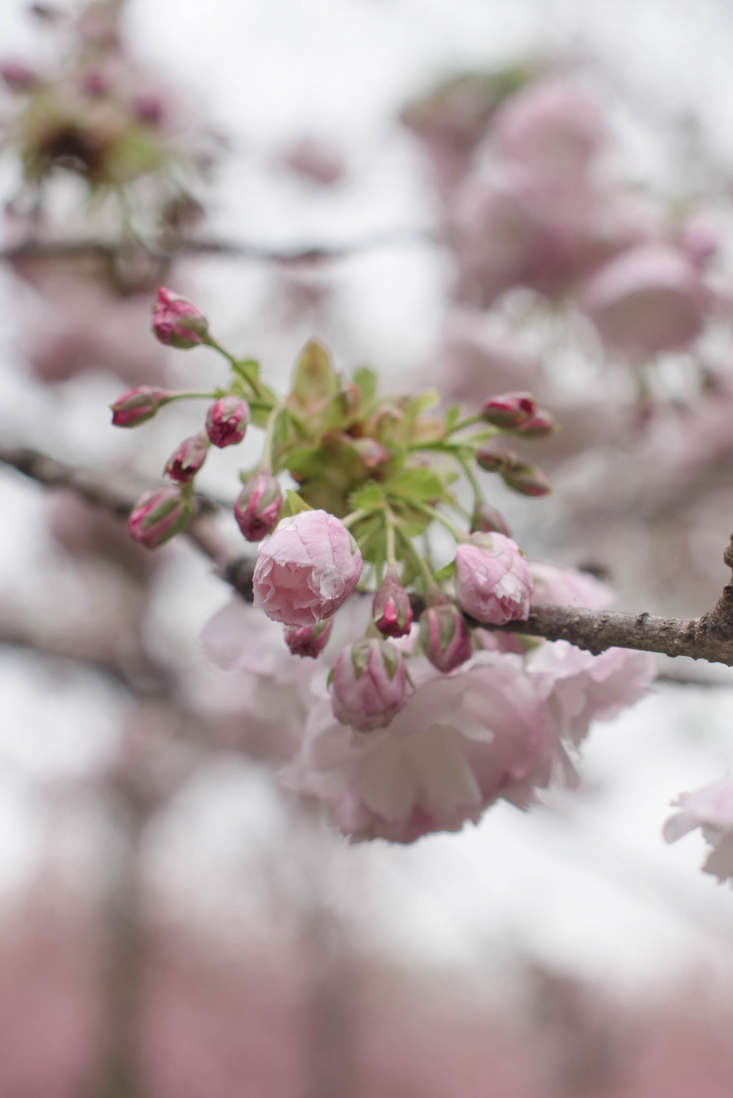Cherry blossoms season is underway, inspiring iPhone-wielding gawkers to head to parks and botanical gardens to catch sight of the billowy pink blossoms. But these show-stopping specimen trees thrive in the home garden as well, so long as they’re kept safe from frost and grown in full sun and well-draining soil. Why not plant your own flowering cherry tree so next year you can revel in its beauty without having to battle crowds?
Flowering cherry trees, which are not to be confused with cherry trees cultivated for fruit, comprise “seven species of Prunus trees and their cultivars, most originating in Japan, with highly ornamental inflorescences,” writes Brian Funk, a cherry curator at the Brooklyn Botanic Garden. (Prunus belongs to the Rosaceae family, along with roses, apricots, raspberries, and plums.)
Inspired by the show this past weekend at the Brooklyn Botanic Garden’s annual cherry blossoms festival, we’ve rounded up six favorite to plant at home:
Photography by Alison Engstrom.
The Classic: Prunus ‘Kanzan’

The ‘Kanzan’ variety, formerly known as ‘Sekiyama,’ is “considered by many to be the most showy ornamental cherry,” according to the Brooklyn Botanic Garden’s guide. Its prized double-flowering blossoms create a fluffy, bright pink canopy.

Though the ‘Kanzan’ tree has a relatively short lifespan (on average, it lives a couple of decades), it likes to be looked at year-round, with stunning fall foliage in addition to spring blooms. Beware: It can grow large—up to 30 feet tall.
Most Photogenic: Prunus serrulata ‘Horinji’

If you really want to impress neighbors and guests, Prunus serrulata ‘Horinji’ is the flowering cherry tree for you. Its blossoms are oversized and puffy, giving it a buoyant, cotton candy-like appearance.

Named after an ancient temple in Kyoto, ‘Horinji’ responds well to pruning and may be more manageable for small gardens: It grows to the relatively petite size of 10-12 feet.
The Ballet Dancer: Prunus serrulata ‘Shogetsu’

For a quiet and graceful tree that adds calm to the garden, consider Prunus serrulata ‘Shogetsu.’ It’s often compared to ballerinas, and no wonder: Its pink-tinged blooms resemble tutus, and its long, delicate boughs are like a dancer’s lithe limbs.

The Canopy: Prunus serrulata ‘Kuramayama’

If you most frequently use your outdoor space for lying about (reading poetry, let’s say, or napping beneath a tree), ‘Kuramayama’ would make a welcome addition to your view: Its multi-layered blooms are best viewed when lounging beneath its branches.
Japanese Simplicity: Prunus ‘Taoyame’

Prunus ‘Taoyame’ may not be as ostentatious as other flowering cherry trees, but in Japan, it’s the simpler, more delicate cherry blossoms that are favored. Proof of their love for ‘Taoyame:’ The name means “attractive woman.”
Pink Lanterns: Prunus serrulata ‘Ojochin’

Do you like the ultra-feminine tulle blooms of ‘Kanzan,’ but prefer a softer pink? Prunus serrulata ‘Ojochin’ may be your match. Its ruffled, multi-layered flowers hang like pendants (the name means “large lantern”), but the color is less bubblegum, more blush.

See also: The Brooklyn Botanic Garden’s guide to Flowering Cherry Trees for Your Own Garden.
Seeking more cherry blossoms? See our post Cherry Blossoms: 7 Trees to See at Brooklyn Botanic Garden’s Festival—and share your bloom snapshots with us on Instagram using the hashtag #GDcherryblossoms.
See more tips for planting and care in our curated design guide to Cherry Trees 101: A Field Guide. For more stunning specimen trees, see:
- Specimen Trees: Are They Worth It?
- Flowering Magnolias: 7 Favorite Trees to Plant.
- 8 Cold-Climate Flowering Shrubs and Small Trees for Early Spring.












Have a Question or Comment About This Post?
Join the conversation (2)